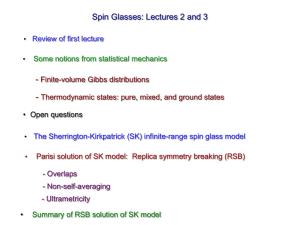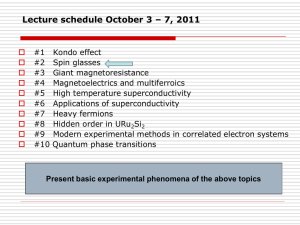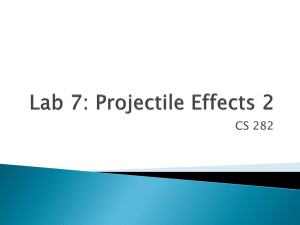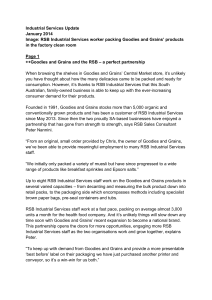Overlaps - Department of Computer Science
advertisement
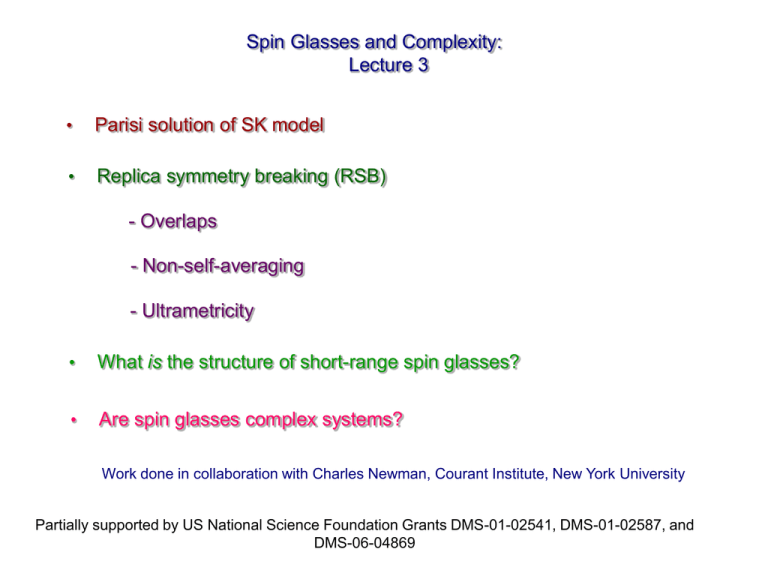
Spin Glasses and Complexity: Lecture 3 • Parisi solution of SK model • Replica symmetry breaking (RSB) - Overlaps - Non-self-averaging - Ultrametricity • What is the structure of short-range spin glasses? • Are spin glasses complex systems? Work done in collaboration with Charles Newman, Courant Institute, New York University Partially supported by US National Science Foundation Grants DMS-01-02541, DMS-01-02587, and DMS-06-04869 Broken symmetry in the spin glass Where we left off: spin glasses (and glasses, …) are characterized by broken symmetry in time but not in space. 1 M lim N N q EA 1 lim N N N i 1 N i 1 0 Si Si 2 0 But remember: this remains a conjecture! Open Questions • Is there a thermodynamic phase transition to a spin glass phase? And if so, does the low-temperature phase display broken spin-flip symmetry (that is, qEA>0)? Most workers in field think so. If yes: • (In How other many words, thermodynamic how many order phases parameters are there?are needed to describe the symmetry of the low-temperature phase?) • If many, what is their structure and organization? And in particular – is it mean-field-like? • What happens when a small magnetic field is turned on? The Edwards-Anderson (EA) Ising Model H J, h J xy x y hx x xy x Coupling and field realization Nearest neighbor spins only 1 in Zd Site The fields and couplings are i.i.d. random variables: 1 P( J xy ) exp[ J xy 2 / 2] 2 1 P(h xSite ) in Zd 2 exp[hx 2 / 2 2 ] 2 The Sherrington-Kirkpatrick (SK) model 1 H J,h, N J ij i j hi i i N i j with i, j 1,, N The fields and couplings are i.i.d. random variables: 1 P( J ij ) exp[ J ij 2 / 2] 2 P( h i ) 1 2 2 exp[hi 2 / 2 2 ] Question: If (as is widely believed) there is a phase transition with broken spin flip symmetry (in zero field), what is the nature of the low temperature phase? And how is it affected by the addition of a small external field? One guide: the infinite-range Sherrington-Kirkpatrick (SK) model displays an exotic ``…the Gibbs equilibrium measure decomposes a mixture of many pure(RSB). new type of broken symmetry, known as into replica symmetry breaking states. This phenomenon was first studied in detail in the mean field theory of spin glasses, where it received the name of replica symmetry breaking. But it can be defined and easily extended to other systems, by considering an order parameter function, the overlap distribution function. This function measures the probability that two configurations of the system, picked up independently with the Gibbs measure, lie at a given distance from each other. Replica symmetry breaking is made manifest when this function is nontrivial.’’ S. Franz, M. Mézard, G. Parisi, and L. Peliti, Phys. Rev. Lett. 81, 1758 (1998). What does this mean? J. Bürki, R.E. Goldstein and C.A. Stafford, Phys. Rev. Lett. 91, 254501 (2003). The Parisi solution of the SK model First feature: the Parisi solution of the SK model has many thermodynamic states! i i G. Parisi, Phys. Rev. Lett. 43, 1754 (1979); 50, 1946 (1983) for many i Thermodynamic States • A thermodynamic state is a probability measure on infinite-volume spin configurations • We’ll denote a state by the index α, β, γ, … • A given state α gives you the probability that at any moment spin 1 is up, spin 18 is down, spin 486 is down, … • Another way to think of a state is as a collection of all long-time averages x , x y , x y z , (These are known as correlation functions.) Overlaps andbetween their distribution Second feature: relationships states are characterized by their overlaps. The overlap qβ between states and β in a volume L is defined to be: 1 q L x L x x with 1 q L x L x 2 qEA so that, for any , β, -qEA ≤ qβ ≤ qEA . M. Mézard et al., Phys. Rev. Lett. 52, 1156 (1984); J. Phys. (Paris) 45, 843 (1984) is a classical field defined on the interval [-L/2,L/2] Their overlap density is: It is subject to a potential like PJ (q) WW (q q ) , commonly called the Parisi overlap distribution. or Example: Uniform Ising ferromagnet below Tc. 1 1 2 2 Now add noise … classical (thermal) or quantum mechanical Replica symmetry breaking (RSB) solution of Parisi for the infinite-range (SK) model: nontrivial overlap structure and non-self-averaging. Nontrivial overlap structure: Non-self-averaging: J21 So, when average over all coupling realizations: Ultrametricity Third feature: the space of overlaps of states has an ultrametric structure. In an ordinary metric space, any three points x, y, and z must satisfy the triangle inequality: d ( x, z) d ( x, y) d ( y, z ) But in an ultrametric space, all distances obey the strong triangle inequality: d ( x, z ) max(d ( x, y), d ( y, z )) which is equivalent to d ( x, z) d ( x, y) d ( y, z) (All triangles are acute isosceles!) There are no in-between points. What kind of space has this structure? R. Rammal, G. Toulouse, and M.A. Virasoro, Rev. Mod. Phys. 58, 765 (1986) Answer: a nested (or tree-like or hierarchical) structure. Kinship relations are an obvious example. d d d H. Simon, ``The Organization of Complex Systems’’, in Hierarchy Theory – The Challenge of Complex Systems, ed. H.H. Pattee, (George Braziller, 1973). 3 4 4 ``…the Gibbs equilibrium measure decomposes into a mixture of many pure states. This phenomenon was first studied in detail in the mean field theory of spin glasses, where it received the name of replica symmetry breaking. But it can be defined and easily extended to other systems, by considering an order parameter function, the overlap distribution function. This function measures the probability that two configurations of the system, picked up independently with the Gibbs measure, lie at a given distance from each other. Replica symmetry breaking is made manifest when this function is nontrivial.’’ S. Franz, M. Mézard, G. Parisi, and L. Peliti, Phys. Rev. Lett. 81, 1758 (1998). The four main features of RSB: 1) Infinitely many thermodynamic states (unrelated by any simple symmetry transformation) 2) Infinite number of order parameters, characterizing the overlaps of the states 3) Non-self-averaging of state overlaps (sample-to-sample fluctuations) 4) Ultrametric structure of state overlaps Very pretty, but is it right? And if it is, how generic is it? • As a solution to the SK model, there are recent rigorous results that support the correctness of the RSB ansatz. • As for its genericity … … there are numerous indications that the SK model is pathological and that the RSB symmetry-breaking structure does not apply to realistic spin glasses. F. Guerra and F.L. Toninelli, Commun. Math. Phys. 230, 71 (2002); M. Talagrand, Spin Glasses: A Challenge to Mathematicians (Springer-Verlag, 2003) In fact: the most straightforward interpretation of this statement (the ``standard RSB picture’’) --- a thermodynamic Gibbs state ρJ decomposable into pure states whose overlaps are non-self-averaging --- cannot happen in any finite dimension. Reason essentially the same as why (e.g.) one can’t have a phase transition for some coupling realizations and infinitely many for others. Follows from the ergodic theorem for translation-invariant functions on certain probability distributions. C.M. Newman and D.L. Stein, Phys. Rev. Lett. 76, 515 (1996); J. Phys.: Condensed Matter 15, R1319 (2003). Other possible scenarios • • Droplet/scaling Chaotic pairs (Macmillan, (Newman and Bray Stein): and Moore, like RSB, Fisher there and areHuse): uncountably theremany is only a single ofconsists global spin-reversed pure states. states , butpair each of a single pair of pure states. So RSB is unlikely to hold for any realistic spin glass model, at any temperature in any finite dimension. In some ways, this Why? is an even stranger departure from the behavior of ordered systems than RSB. Combination of disorder and physical couplings scaling to zero as N (Recall the `physical’ coupling in the SK model is Jij/N) Are Spin Glasses Complex Systems? • Most of the ``classic’’ features that earned spin glasses the title ``complex system’’ are still intact: -- disorder and frustration -- many metastable states -- ``rugged energy landscape’’ -- anomalous dynamics (irreversibility, history dependence, memory effects, aging … • • Connections to problems in computer science, biology, economics, … RSB structure can hold in a variety of nonphysical problems (random TSP, k-SAT, …) D.L. Stein,• ``Spin Glasses: as Stillemergent Complex After All These Years?’’, in Quantum Hierarchies property! Decoherence and Entropy in Complex Systems, ed. T.-H. Elze (Springer, 2004). But there are also some important and interesting newly discovered properties … • Singular d→∞ limit • Absence of straightforward thermodynamic limit for states and ``chaotic size dependence’’ -- Analogy between behavior of correlation functions x, x y , …as volume increases and phase space trajectory of chaotic dynamical system -- Led to concept of metastate • Connection between finite and infinite volumes far more subtle than in homogeneous systems C.M. Newman and D.L. Stein, Phys. Rev. B 46, 973 (1992).
